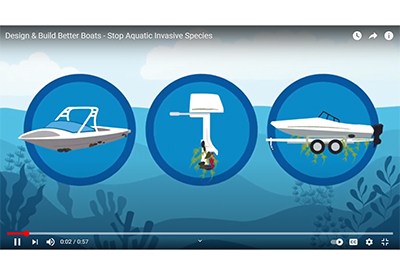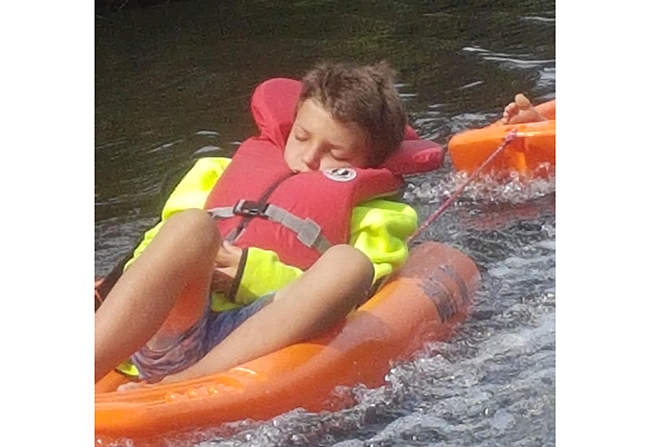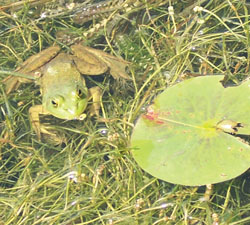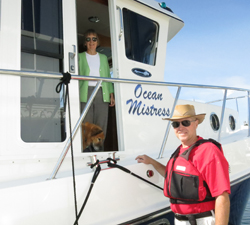Star light, star bright
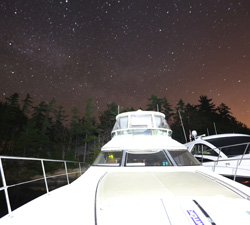
Story by Jennifer Harker
Photos by Paul Jewer
Boating and astronomy can be a match made in the heavens
The inky black canvas above the boat is punctuated by sparkling pinpricks of brilliant light. As if on cue, a meteor blazes across the sky, its dramatic trail tracing its path.
It’s a mid-August night at Beausoleil Island in southern Georgian Bay. The moon has already plummeted below the tree line on a cloudless night, setting the stage for the Perseid meteor show, an annual display easily observed from the deck of a boat at anchor.
That’s one of the advantages of being a boater and amateur astronomer said Dave Lane, past president of the Royal Astronomical Society of Canada. “Generally speaking you’re out in rural areas where it’s dark. Today there’s so much light pollution from human activity it’s hard to see the stars where we live. But on a boat the stars shine like they don’t at home.”
Last March Lane enjoyed phenomenal star gazing while aboard a friend’s sailboat travelling from the US Virgin Islands to the Bahamas. “The brilliance of the sky that far away from land, there’s no light pollution and it was the darkest skies I’ve ever seen.”
For decades this amateur astronomer has had a small observatory at his home in Stillwater, N. S. But it’s the last seven years aboard his C&C 29 Leva (aptly named after one of Magellan’s constellations) that have opened up the skies in a new way. “One of my favourite parts of boating is showing fellow boaters who are unaware of the stars.” Using a green laser pointer he highlights constellations, planets, satellites and even the International Space Station circling the earth. Lane recommends www.heavens-above.com for tracking the ISS’s path and other satellites or a cellphone app to learn what’s visible from your location. “In the old days you didn’t know which ones you were looking at but now with a Smartphone you can go to the site and watch.”
Lane said, “Star gazing and boating has its limitations as you’re on a moving platform.” A telescope might not be the best bet however “naked-eye” astronomy is still rewarding or better yet, reach for those marine binoculars. “A lot of people don’t realize the power of binoculars. They’re looking at other boats and navigation marks with them and don’t realize they’re good for the stars too. They magnify and make it brighter.” With binoculars viewers can see individual stars in the Milky Way, star clusters and nebulas.
According to Lane 7×50 or 10×50 binoculars are all that’s needed, but, “If you can afford it a nice addition is image stabilizing binoculars.” With the same anti-shake technology that eliminates blurring as the new Canon camera lens Lane said, “They are awesome.”
Kent Goranson, owner of Focus Scientific in Ottawa, fondly recalls an amazing star gazing experience. “The best look at the Perseid meteor shower that I ever had was from a small boat, a punt, in the middle of a lake. It was 30 years ago and I still remember it well.”
While special equipment isn’t necessary, it does add to the experience. “A pair of 7×50 marine binoculars will pick up many deep space objects. As well as the four moons around Jupiter, good looks at a crescent moon, mid-summer the Lagoon nebula. The moon looks fantastic when in partial phase.” Many objects on the Messier Catalogue of astronomical objects can be easily seen with normal navigation binoculars (Google Messier List or Catalogue for details).
Although Goranson said a boat is an unsuitable platform for a telescope, boaters do have access to remote destinations far from light sources and may want to consider packing one along to set up on shore. “You want something you can board and unboard easily,” Goranson said. “To be safe, something you can hold in one hand. Some people want a telescope they can use for nature watching as well. You can spend from $100 to $4000 and still be portable enough to pack.” He recommends the reasonably priced and versatile Sky-Watcher 1145. “It weighs 18 pounds so it one hands easily. It’s good for light to medium serious astronomy and costs a little over $200.”
Whatever boaters use they need to beware of moisture. “You’ve got to protect optics on a boat. They need to be kept dry.” He said, “Silica gel in a garbage bag will protect it reasonably well or at least throw a pound of rice in it.” Rice is a good moisture absorber as Goranson points out if a cellphone gets wet, put it in a bowl with dry uncooked white rice to draw the moisture out.
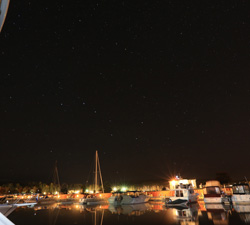 So what to look for and where? “Constellations are the first thing to look for,” RASC’s Lane said. Use a star chart analog computing instrument called a planisphere, essentially two adjustable disks that rotate to show the stars visible on any day and time at the viewer’s latitude. Planispheres are available at science shops or planetariums or visit www.star-finder.ca for a downloadable one. Lane also recommends the Canadian magazine Sky News. He said the summer issues include an annual star chart with details of what’s going each month. In mid-summer 2014 Lane said Mars and Saturn will be visible in the southwestern sky.
So what to look for and where? “Constellations are the first thing to look for,” RASC’s Lane said. Use a star chart analog computing instrument called a planisphere, essentially two adjustable disks that rotate to show the stars visible on any day and time at the viewer’s latitude. Planispheres are available at science shops or planetariums or visit www.star-finder.ca for a downloadable one. Lane also recommends the Canadian magazine Sky News. He said the summer issues include an annual star chart with details of what’s going each month. In mid-summer 2014 Lane said Mars and Saturn will be visible in the southwestern sky.
Even today’s advanced technology isn’t foolproof. “If your GPS does fail and the sun has set you can still find out your direction by simply finding the North Star. You can steer by following the star rather than a bouncing compass,” Lane said, quoting John Mansfield’s Sea Fever poem, “And all I ask is a tall ship and a star to steer by.”
John Gullick, manager for government and special programs with the Canadian Power and Sail Squadrons said CPS covers celestial navigation in two of their most advanced courses, junior navigator and navigator. Topics include introduction to a sextant, how it works, history, various star shots and sun shots, celestial and electronic navigation. “It’s a bit of a dying art,” Gullick said, “It’s more for their own interest than functional, however it’s still of use, with a lot of good information. Some who are starting to look at global travel and want to have a non-electronic back-up do it.”
The information is useful for everyday purpose whether hiking, boating or on a road trip. “You get a sense of where you are,” Gullick said. After learning to use a sextant, the sun and stars he said, “My personal sense of direction improved dramatically, how to best find where I was and keep moving in the right direction rather than going in circles.”
While the demand for the CPS advanced navigation courses is greater in urban areas and coastal communities, Gullick said even if courses aren’t listed on their website www.cps-ecp.ca call the closest squadron and ask. “Call and say ‘I have an interest’. We do have students who work on it as home study with a mentor and work at a distance. It works well in more remote areas.”
Whether it’s functional navigation or enjoying the dark sky while anchored, knowing the stars and constellations is a great activity for boaters of all ages.
For kids: Janet Weersink of Minds Alive in Midland recommends The Kids Book of the Night Sky as a great introduction to the constellations and the mythology of their names, as well as Exploring the Night Sky and Peterson First Guide to Astronomy. “We also had a telescope when the kids were little, but one of our favourite things to do was lying on the dock at night watching the meteor showers and making a wish on all the shooting stars.”
Web resources: Track satellites and the International Space Station with www.heavens-above.com or download a planisphere on www.star-finder.ca
For awesome viewing onshore check out the Torrance Barrens Dark Sky Preserve, off District Road 13, near the Village of Torrance in Central Ontario. Designated a conservation reserve in 1997, in 1999 it was officially named a dark sky preserve, recognizing the remote area’s value as a unique destination far from urban light leakage.
Learn more: Check the Royal Astronomical Society of Canada www.rasc.ca for news of new dark sky preserves, what to watch for in the night sky and other fascinating resources.
Photo Captions
Photo 1: Night sky magic: At dark anchorages far from the light pollution of populated centres the night sky opens to reveal its timeless beauty to boaters.
Photo 2: The Big Dipper hangs majestically over boats at Beacon Bay Marina in Penetanguishene. Knowing the constellations and their locations in the sky is a great activity for boaters.


